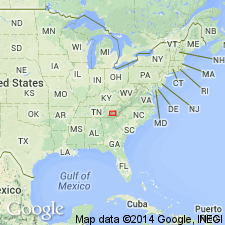
- Usage in publication:
-
- Roaring Fork sandstone*
- Modifications:
-
- Named
- Dominant lithology:
-
- Sandstone
- Siltstone
- Claystone
- AAPG geologic province:
-
- Appalachian basin
Summary:
Named as a formation in Snowbird group of Ocoee series. Named for Roaring Fork, a stream 1 to 3 mi southeast of Gatlinburg, Sevier Co., eastern TN. Type locality is along Roaring Fork. Somewhat less than half of formation consists of massive, light-greenish-gray, fine- to medium-grained, highly feldspathic, and moderately sorted sandstone in beds 5 to 50 ft thick. Interbedded with them are thick- to thin-bedded, finer grained, thinner bedded sandstone. Thickness is 8,000 ft at type locality. Lies conformably below Pigeon siltstone; base is cut off by fault at type locality, but decreases in thickness and intertongues eastward with Longarm quartzite. Report includes correlation chart and geologic map. Age is later Precambrian.
Source: GNU records (USGS DDS-6; Reston GNULEX).
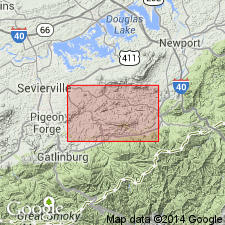
- Usage in publication:
-
- Roaring Fork sandstone*
- Modifications:
-
- Overview
- AAPG geologic province:
-
- Appalachian basin
Summary:
Roaring Fork sandstone is here lowest formation of Snowbird group of Ocoee series. Lies beneath and partly intertongues with Pigeon siltstone of Snowbird group. Age is late Precambrian. Report includes geologic map, cross sections, correlation chart, and measured sections.
Source: GNU records (USGS DDS-6; Reston GNULEX).
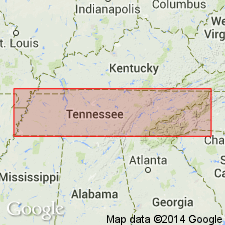
- Usage in publication:
-
- Roaring Fork Sandstone
- Modifications:
-
- Overview
- AAPG geologic province:
-
- Appalachian basin
Summary:
In Unaka Mountains, used as Precambrian Roaring Fork Sandstone of Snowbird Group of Ocoee Supergroup.
Source: GNU records (USGS DDS-6; Reston GNULEX).
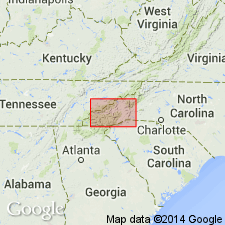
- Usage in publication:
-
- Roaring Fork Sandstone*
- Modifications:
-
- Areal extent
- Overview
- AAPG geologic province:
-
- Piedmont-Blue Ridge province
- Appalachian basin
Summary:
Included in Snowbird Group of Ocoee Series. Mapped in Blue Ridge belt northwest of Greenbrier-Devils Fork fault in Sevier and Cocke Cos., eastern TN, and in Haywood and Madison Cos., northwestern NC. Consists of light- to medium-greenish-gray, fine- to medium-grained, thin- to thick-bedded, locally current bedded, highly feldspathic metasandstone interbedded with dark, sandy metasiltstone and minor pale-green phyllite. Locally includes beds of coarse, feldspathic sandstone like underlying unit; intertongues extensively with overlying and underlying units. Southeast of Greenbrier-Devils Fork fault, mapped together with Longarm Quartzite and Wading Branch Formation, both of Snowbird Group, in Swain and Haywood Cos., NC. Combined units consist of mostly light-colored feldspathic quartzite or metasandstone and interbedded dark quartz-feldspar-mica schist; contains basal unit of micaceous phyllite or schist with rare quartz-pebble conglomerate. Age is late Precambrian.
Source: GNU records (USGS DDS-6; Reston GNULEX).
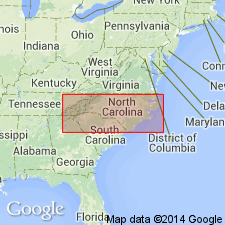
- Usage in publication:
-
- Roaring Fork Sandstone
- Modifications:
-
- Overview
- AAPG geologic province:
-
- Piedmont-Blue Ridge province
Summary:
In Blue Ridge belt, used as Late Proterozoic Roaring Fork Sandstone of Snowbird Group of Ocoee Supergroup.
Source: GNU records (USGS DDS-6; Reston GNULEX).
For more information, please contact Nancy Stamm, Geologic Names Committee Secretary.
Asterisk (*) indicates published by U.S. Geological Survey authors.
"No current usage" (†) implies that a name has been abandoned or has fallen into disuse. Former usage and, if known, replacement name given in parentheses ( ).
Slash (/) indicates name conflicts with nomenclatural guidelines (CSN, 1933; ACSN, 1961, 1970; NACSN, 1983, 2005, 2021). May be explained within brackets ([ ]).

